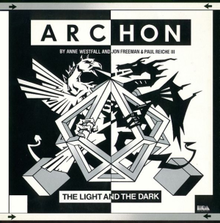Archon (computer game)
| Archon: The Light and the Dark | |
|---|---|

Cover art
|
|
| Developer(s) | Free Fall Associates |
| Publisher(s) |
Electronic Arts Ariolasoft (Europe) |
| Designer(s) |
Jon Freeman Paul Reiche III |
| Programmer(s) | Anne Westfall |
| Platform(s) | Atari 8-bit (original) Apple II, C64, Amiga, MS-DOS, Macintosh, NES, Amstrad CPC, ZX Spectrum, PC-88 |
| Release | 1983 |
| Genre(s) | Strategy |
| Mode(s) | Single player or Two player |
Archon: The Light and the Dark is a 1983 video game developed by Free Fall Associates and one of the first five games published by Electronic Arts. It's similar in concept to Chess, except that landing on another player's piece results in an arcade-style fight to determine the victor.
Archon was originally developed for Atari 8-bit family, then ported to the Apple II, Commodore 64, Amstrad CPC, ZX Spectrum, Amiga, IBM PC, Macintosh, PC-88, and NES. It was designed by Paul Reiche III (who also created the graphics for the game) and Jon Freeman, and programmed by Anne Westfall.
A sequel was released in 1984: Archon II: Adept.
The goal of the game is either to take control of five power points located on the board, to eliminate all the opposing pieces, or to eliminate all but one remaining imprisoned piece of the opponent's.
While the board is similar to a chessboard, and the various pieces are similarly designed to have various offsetting abilities, when one piece attempts to take another, the removal of the targeted piece is not automatic. Instead, the two pieces are placed into a full-screen 'combat arena' and must battle (action-style, with the players running the pieces) to determine who takes the square.
Generally (but not always) in combat, a stronger piece will defeat a weaker piece in either defending or capturing a square. It is also possible for the fight to result in a double-kill, in which both pieces are eliminated. This uncertainty adds a level of complexity into the game, since it is not always possible to predict if taking a square will be successful. Different pieces have different abilities in the combat phase. These include movement, lifespan, and weapon damage and attributes. The weapons vary by range, speed, rate-of-fire, and power. For example, the pawn (represented by knights on the 'light' side and goblins on the 'dark' side) attacks quickly, but has very little strength; its weapon, a sword or club, has limited reach and power. A dragon is considerably stronger and can attack from a distance, while a golem moves slowly and fires a slow but powerful boulder.
...
Wikipedia
